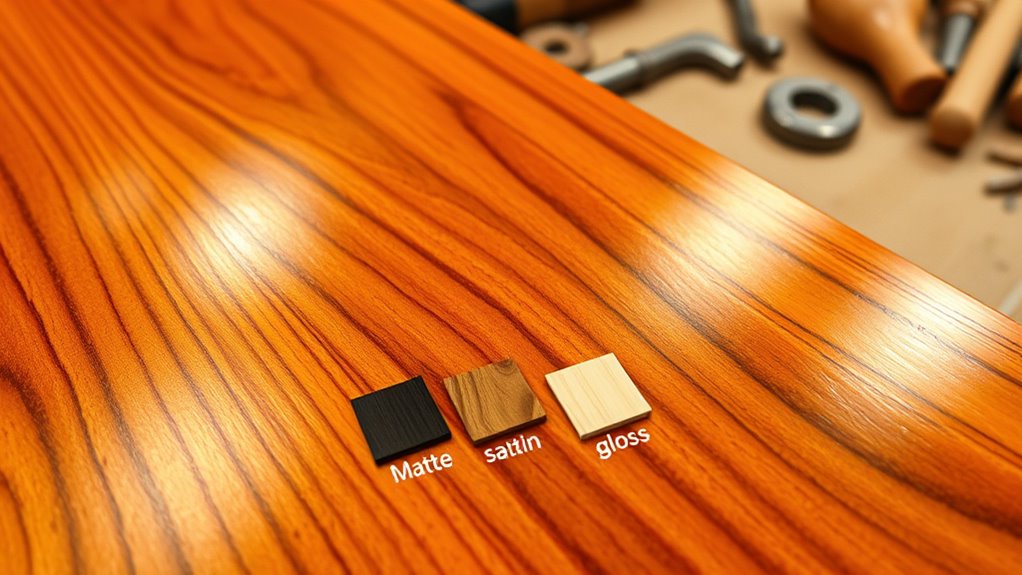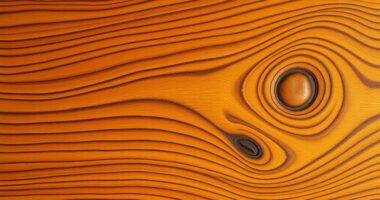To choose the right wood finish, consider your project’s look—whether you want a natural, enhanced, or painted surface. Think about the wood species and pore structure to pick a compatible stain or gloss. Assess how durable your finish needs to be, especially for high-use or outdoor items, and choose protective options like polyurethane or varnish if necessary. Don’t forget environmental safety; opt for eco-friendly and low-VOC products. Keep these tips in mind to achieve a beautiful, lasting result that suits your needs.
Key Takeaways
- Determine whether you want a natural look to showcase wood grain or a colored/opaque finish for a specific aesthetic.
- Consider the wood species and pore structure to choose a finish that enhances or fills the grain appropriately.
- Match the finish’s durability to the item’s use, opting for high-protection options like polyurethane for high-traffic or outdoor pieces.
- Prepare the surface properly and select application methods that ensure smooth, even coverage for a professional result.
- Prioritize environmentally friendly and low-VOC finishes if indoor air quality and safety are concerns.

Choosing the right wood finish is essential to achieving the look and durability you want for your project. The type of finish you select influences not only how your wood appears but also how well it withstands daily wear and environmental factors. To start, consider whether you prefer a natural look or want to add color. Clear finishes like penetrating oils or water-based options emphasize the wood’s grain and texture, keeping the natural beauty intact. If you want to enhance the warmth or deepen the color, oil-based finishes or varnishes are good choices, giving your wood a golden, rich tone. On the other hand, stains let you change the color while still showing the grain, whereas paint provides a uniform, opaque cover if you prefer a different look altogether. Your choice should also factor in the wood species. Different woods react uniquely to various finishes. For example, woods with large pores, such as Red Oak, may require pore filling to achieve a smooth surface. Oil-based finishes tend to deepen and warm the color of such woods, while water-based finishes keep the tone lighter. Medium-pored woods like Black Walnut might need filling too if you’re aiming for a glass-smooth finish. Keep in mind that some species are more stainable than others, requiring multiple steps to darken or alter their natural hues effectively. Durability is another key factor. For pieces exposed to high traffic, moisture, or outdoor conditions, you’ll need tougher protective finishes. Polyurethane is highly resistant to water and scratches, making it ideal for tabletops, floors, or outdoor furniture. Varnishes also offer protective qualities, though they’re generally less durable than polyurethanes. Lacquers dry quickly and are easy to apply but might need multiple coats for better protection. Penetrating oils, while excellent for highlighting wood’s natural grain, don’t resist surface damage as well and are better suited for decorative or low-use items. Application techniques matter, too. The type of brush, spray, or wipe you use can affect the finish’s smoothness and evenness. Applying multiple thin coats and sanding lightly between them improves adhesion and results in a more polished look. Proper surface preparation—cleaning, sanding, and conditioning—sets the stage for a successful finish. It’s also important to consider the environmental impact, as some finishes contain VOCs that can affect indoor air quality. Additionally, choosing the right finish can influence the overall aesthetic and longevity of your project, especially when considering the environmental and health impacts of different products. Finally, consider environmental and health impacts: water-based finishes emit fewer VOCs and are safer indoors, while oil-based products often have stronger odors and require protective gear during application. Choosing the right finish involves balancing appearance, durability, application ease, and safety. By understanding these factors, you can select a finish that best enhances your wood and meets your project’s needs.
Conclusion
So, next time you pick a wood finish, remember: the easiest choice isn’t always the best. Sometimes, the most durable or beautiful option requires a little extra effort and research. But hey, who needs all that fuss when you can just slap on whatever’s handy? Just don’t be surprised if your “quick fix” turns into a long-term disappointment. After all, choosing the right finish isn’t just about looks — it’s about making your wood last.









